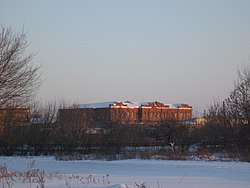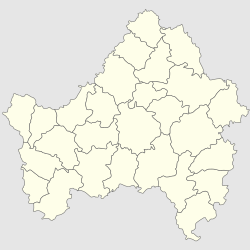Starodub
Starodub
Стародуб | |
|---|---|
 Starodub | |
| Coordinates: 52°35′N 32°46′E / 52.583°N 32.767°E | |
| Country | Russia |
| Federal subject | Bryansk Oblast[2] |
| Known since | 11th century |
| Elevation | 180 m (590 ft) |
| Population | |
| • Total | 19,010 |
| • Subordinated to | Starodubsky Urban Administrative Okrug (town of oblast significance)[2] |
| • Capital of | Starodubsky Urban Administrative Okrug,[2] Starodubsky District[1] |
| • Urban okrug | Starodub Urban Okrug[4] |
| • Capital of | Starodub Urban Okrug[4] |
| Time zone | UTC+3 (MSK |
| Postal code(s)[6] | |
| OKTMO ID | 15750000001 |
| Website | starburg |
Starodub (Russian: Староду́б, IPA: [stərɐˈdup], lit. old oak) is a town in Bryansk Oblast, Russia, located on the Babinets River (the Dnieper basin), 169 kilometers (105 mi) southwest of Bryansk. Population: 19,010 (2010 Census);[3] 18,643 (2002 Census);[7] 18,906 (1989 Soviet census);[8] 16,000 (1975).
History
Starodub has been known since the 11th century, when it was a part of Severia.[citation needed] It was burned to the ground by the Mongols in the 13th century. It became a part of the Grand Duchy of Lithuania in the 14th century, and later the Polish-Lithuanian Commonwealth. In 1503–1618, Starodub was a part of the Grand Duchy of Moscow and then Commonwealth until 1648. During the Khmelnytskyi Uprising, Zaporozhian Cossacks seized the town, and 188 families of local Ruthenian nobility recognized the Ukrainian hetman as a new governor.[9] Starodub became the center of Starodub Cossack Regiment and enjoyed a large measure of autonomy between 1666 and 1686.
Starodub remained rudiments of Cossack Hetmanate's administrative division until 1782 when it became an uyezd town. In 1796, Starodub was incorporated into Chernigov Governorate. In 1918, the town was occupied by the Germans. The Soviet authority was reinstated in November 1918.
During the Soviet period, Starodub was a part of Gomel Governorate (1919–1926), Bryansk Governorate (1926–1929), Western Oblast (1929–1937), and Oryol Oblast (1937–1944). The town was once again occupied by the Germans between August 18, 1941 and September 22, 1943. Starodub finally became a part of Bryansk Oblast in 1944.
Administrative and municipal status
Within the framework of administrative divisions, Starodub serves as the administrative center of Starodubsky District,[1] even though it is not a part of it.[2] As an administrative division, it is incorporated separately as Starodubsky Urban Administrative Okrug—an administrative unit with the status equal to that of the districts.[1] As a municipal division, Starodubsky Urban Administrative Okrug is incorporated as Starodub Urban Okrug.[2]
Prior to January 1, 2013, Starodub was administratively incorporated as a town of district significance within Starodubsky District.
Architecture
As a significant center of the Cossack Hetmanate, Starodub is the only place in Russia where authentic examples of Ukrainian Baroque may be seen. The Nativity Cathedral, built in 1617 and overhauled after a conflagration in 1677, is a typical example of Cossack Baroque. The Epiphany Church goes back to 1789, while the Church of St. Nicholas was erected in the Neoclassical style in 1802.
Notable people from Starodub
References
Notes
- ^ a b c d Law #13-Z
- ^ a b c d e Law #69-Z
- ^ a b Russian Federal State Statistics Service (2011). Всероссийская перепись населения 2010 года. Том 1 [2010 All-Russian Population Census, vol. 1]. Всероссийская перепись населения 2010 года [2010 All-Russia Population Census] (in Russian). Federal State Statistics Service.
- ^ a b Law #3-Z
- ^ "Об исчислении времени". Официальный интернет-портал правовой информации (in Russian). June 3, 2011. Retrieved January 19, 2019.
- ^ Почта России. Информационно-вычислительный центр ОАСУ РПО. (Russian Post). Поиск объектов почтовой связи (Postal Objects Search) (in Russian)
- ^ Federal State Statistics Service (May 21, 2004). Численность населения России, субъектов Российской Федерации в составе федеральных округов, районов, городских поселений, сельских населённых пунктов – районных центров и сельских населённых пунктов с населением 3 тысячи и более человек [Population of Russia, Its Federal Districts, Federal Subjects, Districts, Urban Localities, Rural Localities—Administrative Centers, and Rural Localities with Population of Over 3,000] (XLS). Всероссийская перепись населения 2002 года [All-Russia Population Census of 2002] (in Russian).
- ^ Всесоюзная перепись населения 1989 г. Численность наличного населения союзных и автономных республик, автономных областей и округов, краёв, областей, районов, городских поселений и сёл-райцентров [All Union Population Census of 1989: Present Population of Union and Autonomous Republics, Autonomous Oblasts and Okrugs, Krais, Oblasts, Districts, Urban Settlements, and Villages Serving as District Administrative Centers]. Всесоюзная перепись населения 1989 года [All-Union Population Census of 1989] (in Russian). Институт демографии Национального исследовательского университета: Высшая школа экономики [Institute of Demography at the National Research University: Higher School of Economics]. 1989 – via Demoscope Weekly.
- ^ Kotljarchuk, Andrej (2006). In the Shadows of Poland and Russia: the Grand Duchy of Lithuania and Sweden in the European Crisis of the mid-17th Century (PDF) (PhD dissertation). Södertörn University. p. 237. ISBN 9789189315631.
Sources
- Брянская областная Дума. Закон №13-З от 5 июня 1997 г. «Об административно-территориальном устройстве Брянской области», в ред. Закона №4-З от 5 февраля 2014 г. «О внесении изменений в отдельные законодательные акты Брянской области». Опубликован: "Брянский рабочий", №119, 24 июня 1997 г. (Bryansk Oblast Duma. Law #13-Z of June 5, 1997 On the Administrative-Territorial Structure of Bryansk Oblast, as amended by the Law #4-Z of February 5, 2014 On Amending Various Legislative Acts of Bryansk Oblast. ).
- Брянская областная Дума. Закон №69-З от 2 ноября 2012 г. «Об образовании городских административных округов, поселковых административных округов, сельских административных округов, установлении границ, наименований и административных центров административных округов в Брянской области». Вступил в силу 1 января 2013 г. Опубликован: Информационный бюллетень "Официальная Брянщина", №16, 6 ноября 2012 г.. (Bryansk Oblast Duma. Law #69-Z of November 2, 2002 On the Establishment of Urban Administrative Okrugs, Settlement Administrative Okrugs, Rural Administrative Okrugs, on Establishing Borders, Names, and Administrative Centers of the Administrative Okrugs of Bryansk Oblast. Effective as of January 1, 2013.).
- Брянская областная Дума. Закон №3-З от 9 марта 2005 г. «О наделении муниципальных образований статусом статусом городского округа, муниципального района, городского поселения, сельского поселения и установлении границ муниципальных образований в Брянской области», в ред. Закона №75-З от 28 сентября 2015 г. «Об изменении статуса населённого пункта посёлок Красный Ятвиж Клетнянского района Брянской области». Вступил в силу через 10 дней после официального опубликования. Опубликован: "Брянская неделя", №13, 8 апреля 2005 г. (Bryansk Oblast Duma. Law #3-Z of March 9, 2005 On Granting the Municipal Formations the Status of Urban Okrug, Municipal District, Urban Settlement, Rural Settlement and on Establishing the Borders of the Municipal Formations of Bryansk Oblast, as amended by the Law #75-Z of September 28, 2015 On Changing the Status of the Inhabited Locality the Settlement of Krasny Yatvizh in Kletnyansky District of Bryansk Oblast. Effective as of the day which is 10 days after the official publication.).
External links
- Official website of Starodub (in Russian)
- Unofficial website of Starodub (in Russian)
- The murder of the Jews of Starodub during World War II, at Yad Vashem website.





